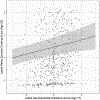Associations of developmental imbalance between sensation seeking and premeditation in adolescence and heavy episodic drinking in emerging adulthood
- PMID: 33991389
- PMCID: PMC8254779
- DOI: 10.1111/acer.14604
Associations of developmental imbalance between sensation seeking and premeditation in adolescence and heavy episodic drinking in emerging adulthood
Abstract
Background: Dual systems theories suggest that greater imbalance between higher reward sensitivity and lower cognitive control across adolescence conveys risk for behaviors such as heavy episodic drinking (HED). Prior research demonstrated that psychological analogues of these systems, sensation seeking and premeditation, change from childhood through emerging adulthood, and each has been independently linked with HED. However, few studies have assessed whether change over time in these developing analogues is prospectively associated with HED. Moreover, we know of no research that has shown whether within-person differences between higher sensation seeking and relatively lower premeditation across the adolescent period predict HED in emerging adulthood.
Methods: Prospective data from the National Consortium on Alcohol and NeuroDevelopment in Adolescence study (n = 715) were used to examine the association of sensation seeking and premeditation with HED among adolescents ages 16 to 20 years. We used novel applications of latent difference score modeling and growth curve analysis to test whether increasing sensation seeking, premeditation, and their imbalance over time are associated with HED across the study period, and whether these associations differed by sex.
Results: Whereas premeditation increased linearly from adolescence through emerging adulthood across sexes, males reported growth and females reported decline in sensation seeking. Sensation seeking in adolescence (and not premeditation) was associated with higher levels of HED by emerging adulthood. Importantly, greater imbalance between sensation seeking and premeditation was associated with higher levels of HED by emerging adulthood though we note that variability capturing this imbalance correlated highly (r = 0.86) with baseline levels of sensation seeking.
Conclusions: Developmental imbalance between higher sensation seeking and lower premeditation in late adolescence may be a risk factor for greater HED in emerging adulthood.
Keywords: adolescence; alcohol use; dual systems; impulse control; sensation seeking.
© 2021 by the Research Society on Alcoholism.
Conflict of interest statement
CONFLICT OF INTEREST
The authors declare no conflicts of interest.
Figures


Similar articles
-
Sex differences in the developmental trajectories of impulse control and sensation-seeking from early adolescence to early adulthood.J Youth Adolesc. 2015 Jan;44(1):1-17. doi: 10.1007/s10964-014-0116-9. Epub 2014 Mar 30. J Youth Adolesc. 2015. PMID: 24682958
-
Premeditation moderates the relation between sensation seeking and risky substance use among young adults.Psychol Addict Behav. 2015 Sep;29(3):753-65. doi: 10.1037/adb0000075. Psychol Addict Behav. 2015. PMID: 26415063 Free PMC article.
-
On Imbalance of Impulse Control and Sensation Seeking and Adolescent Risk: An Intra-individual Developmental Test of the Dual Systems and Maturational Imbalance Models.J Youth Adolesc. 2021 May;50(5):827-840. doi: 10.1007/s10964-021-01419-x. Epub 2021 Mar 20. J Youth Adolesc. 2021. PMID: 33745073 Free PMC article.
-
The dual systems model: Review, reappraisal, and reaffirmation.Dev Cogn Neurosci. 2016 Feb;17:103-17. doi: 10.1016/j.dcn.2015.12.010. Epub 2015 Dec 29. Dev Cogn Neurosci. 2016. PMID: 26774291 Free PMC article. Review.
-
Flexing dual-systems models: How variable cognitive control in children informs our understanding of risk-taking across development.Dev Cogn Neurosci. 2017 Oct;27:91-98. doi: 10.1016/j.dcn.2017.08.007. Epub 2017 Aug 16. Dev Cogn Neurosci. 2017. PMID: 28869843 Free PMC article. Review.
Cited by
-
Binge drinking trajectories across adolescence and early adulthood: Associations with genetic influences for dual-systems impulsive personality traits, alcohol consumption, and alcohol use disorder.medRxiv [Preprint]. 2024 Oct 16:2024.10.15.24315471. doi: 10.1101/2024.10.15.24315471. medRxiv. 2024. PMID: 39484268 Free PMC article. Preprint.
-
Risk Factors for Binge Drinking in Young Adulthood: The Roles of Aggregate Genetic Liability and Impulsivity-Related Processes.J Stud Alcohol Drugs. 2023 Jul;84(4):499-507. doi: 10.15288/jsad.22-00420. Epub 2023 Feb 28. J Stud Alcohol Drugs. 2023. PMID: 36971764 Free PMC article.
-
Self-reported sleep and circadian characteristics predict alcohol and cannabis use: A longitudinal analysis of the National Consortium on Alcohol and Neurodevelopment in Adolescence Study.Alcohol Clin Exp Res. 2022 May;46(5):848-860. doi: 10.1111/acer.14808. Epub 2022 May 17. Alcohol Clin Exp Res. 2022. PMID: 35579668 Free PMC article.
-
Operant novelty seeking predicts cue-induced reinstatement following cocaine but not water reinforcement in male rats.Psychopharmacology (Berl). 2023 Oct;240(10):2201-2215. doi: 10.1007/s00213-023-06441-4. Epub 2023 Aug 8. Psychopharmacology (Berl). 2023. PMID: 37552291 Free PMC article.
-
Neurogenetic and multi-omic sources of overlap among sensation seeking, alcohol consumption, and alcohol use disorder.Addict Biol. 2024 Feb;29(2):e13365. doi: 10.1111/adb.13365. Addict Biol. 2024. PMID: 38380706 Free PMC article.
References
-
- Baraldi AN & Enders CK (2010) An introduction to modern missing data analyses. Journal of School Psychology, 48, 5–37. - PubMed
-
- Brown SA, Myers MG, Lippke L, Tapert SF, Stewart DG & Vik PW (1998) Psychometric evaluation of the customary drinking and drug use record (CDDR): a measure of adolescent alcohol and drug involvement. Journal of Studies on Alcohol, 59, 427–438. - PubMed
Publication types
MeSH terms
Grants and funding
- P50 DA046346/DA/NIDA NIH HHS/United States
- U01 AA021696/AA/NIAAA NIH HHS/United States
- U01 AA021691/AA/NIAAA NIH HHS/United States
- U01 AA021681/AA/NIAAA NIH HHS/United States
- U01 AA021695/AA/NIAAA NIH HHS/United States
- U01 AA021692/AA/NIAAA NIH HHS/United States
- T32 AA013525/AA/NIAAA NIH HHS/United States
- U01 AA021690/AA/NIAAA NIH HHS/United States
- U24 AA021695/AA/NIAAA NIH HHS/United States
- U01 AA021697/AA/NIAAA NIH HHS/United States
- K23 AA026869/AA/NIAAA NIH HHS/United States
- U24 AA021697/AA/NIAAA NIH HHS/United States
LinkOut - more resources
Full Text Sources
Other Literature Sources
Medical

